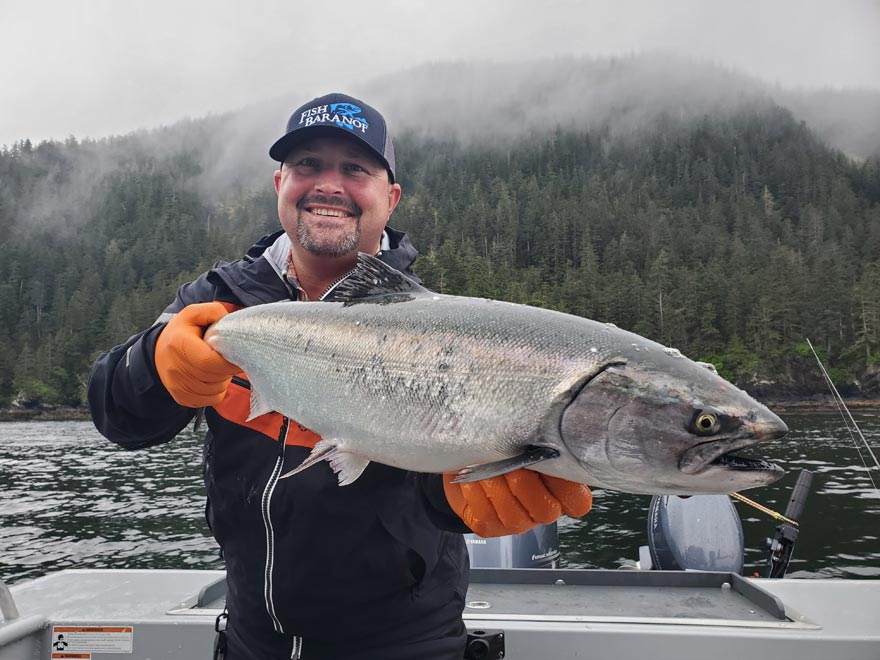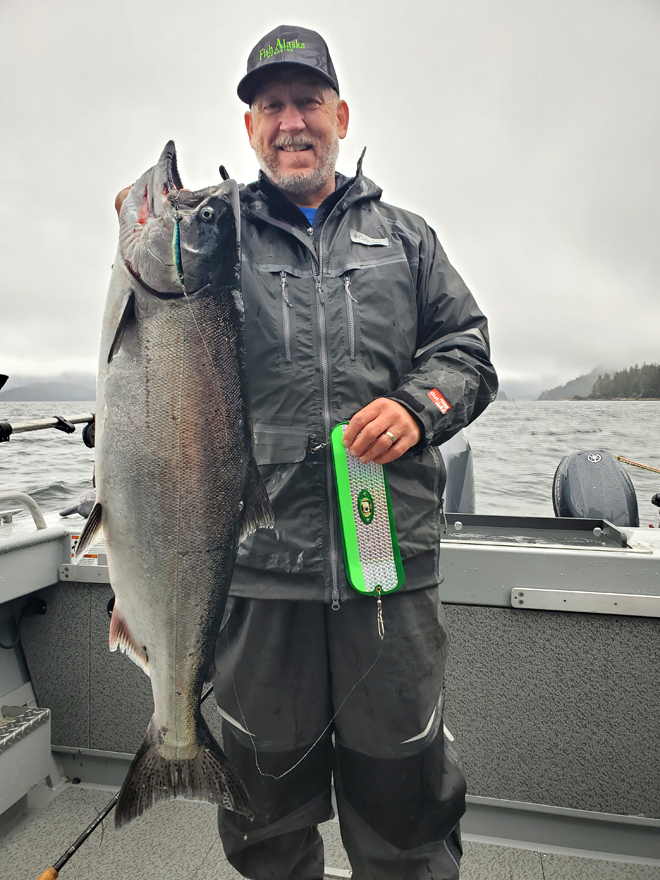Alaska Fishing Report
May 31 – June 5, 2021
 This week’s Sitka, Alaska fishing report came from Austin Moser and Fish Alaska Editor George Krumm. The week was characterized by bad weather limiting most of the sportfishing fleet to inside waters on most days.
This week’s Sitka, Alaska fishing report came from Austin Moser and Fish Alaska Editor George Krumm. The week was characterized by bad weather limiting most of the sportfishing fleet to inside waters on most days.
Chinook angling was good for trollers in Salisbury Sound, especially on the flood tide. The Shark Hole, in particular, produced for anglers tolling Pro-Troll HotChip 11 Flashers and Silver Horde Coho Killer spoons in water from 55 to 80 feet deep, within 10 feet of the bottom. We know of one group of five nonresidents that landed their five kings in an hour and a half near the morning high slack.
During this Alaska fishing report period, closer to town, Vitskari Rocks produced kings as well. Last week, fish were caught at a variety of depths, but near the bottom in 120 feet of water near the northwest side of the rocks was perhaps the most consistent. The afternoon low slack kicked out a few fish for charter anglers on there way back from the halibut grounds, as well as for local Sitka anglers. There are a lot of rockfish in this area. To avoid them, keep your gear at least 10 feet of the bottom, troll faster, or both.
 An Alaska fishing report wouldn’t be complete without reference to bad weather. When the weather allowed, moochers and trollers both scored Chinook at Cape Edgecumbe. Small silvers and pinks also turned up in catches from the Cape. Trollers used flashers trailed by spoons (Coho Killer, Coyote, Kingfisher) or hoochies. The Silver Horde Ace Hi Fly in the Herring Aide pattern has been quite popular this year. Many trollers fished their gear between 100 and 175 feet in water greater than 200 feet deep. Moochers employed plug-cut herring with a 6-ounce mooching lead and fished the same area.
An Alaska fishing report wouldn’t be complete without reference to bad weather. When the weather allowed, moochers and trollers both scored Chinook at Cape Edgecumbe. Small silvers and pinks also turned up in catches from the Cape. Trollers used flashers trailed by spoons (Coho Killer, Coyote, Kingfisher) or hoochies. The Silver Horde Ace Hi Fly in the Herring Aide pattern has been quite popular this year. Many trollers fished their gear between 100 and 175 feet in water greater than 200 feet deep. Moochers employed plug-cut herring with a 6-ounce mooching lead and fished the same area.
Bottomfishing it was good for black rockfish and lingcod in inside waters during this Alaska fishing report period. For black rockfish, fishing the edges of kelp beds in 15- to 40 feet of water resulted in easy limits. Kelp greenling and small lings are also caught in these areas. Small P-Line Laser Minnows and similar metal jigs, and small lead heads with curly-tail grubs were effective. Even the occasional Chinook or halibut is hooked along the kelp by anglers fishing for rockfish. We know of two 60-pound halibut caught last week in near Salisbury Sound by anglers fishing shallow water for rockfish.
Fishing for larger lings has been good on or near rocky pinnacles, and hard, rocky-bottomed areas in general. Jigs like the Ahi Deception Jig, P-Line Laser Minnow and leadhead/grub combinations all produce. Live greenling also produce well if you can catch some. Fish Alaska editor George Krumm likes to fish live greenling on heavy mono leaders (135-pound-test) with two 9/0 hooks snelled about 8 inches apart.
When fishing deeper than 60 feet for lings, rockfish or halibut, ensure you have a descending device rigged and ready to use. There are several nonpelagic rockfish species that can’t be harvested in the Sitka area and must be descended. It’s common to catch these species while targeting lings on rocky structure.
According to Alaska fishing report sources in Sitka, when boats were able to get out to the halibut grounds, limits of halibut were the rule. Most boats were fishing for halibut in water deeper than 250 feet off Cape Edgecumbe. Typical halibut bait rigs and jigs both accounted for fish. Fish harvested have been running from 15- to 35 pounds, for the most part, though much larger fish are caught every day.
